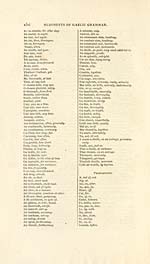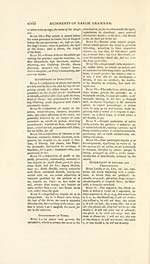Download files
Complete book:
Individual page:
Thumbnail gallery: Grid view | List view

RUDIMENTS OF GAELIC GRAMMAR.
xlvii
Seacli, past, to.
Thar, thairis, above.
Thun, to, towards.
Throimh, through.
Trpimh, through.
Frld, through.
Trid, through.
Bhua, \ia,from.
Compound Prepositichis.
Air beulthaobh, in front.
Air culthaobh, behind.
Air fad. throughout.
Air feadh, throughout.
Air son, on account.
Am raeasg, among.
An aghaidh, against.
An dàil, to meet.
An dèigh, after. •
An deis, after.
An lorg, in consequence.
An tòir, in consequence.
As leith, in behalf of.
A bhrigh, because of.
A chum, to, towards.
A dhith, without.
A rèir, according to.
A thaobh, on account of.
A choir, near to.
Do reir, in proportion to.
Dh' ionnsuidh, to, towards.
Ma choinneamh, opposite to.
Ma thimchioll, aòou^
As ceann, aioKC.
Re, during.
TimchioU, about.
Interjections.
A bab, fie ! Pshaw .' shame .' abomination
ordure !
A mach, oxit! go about your business!
Wonder, òbh! òbh! ùbh.ùbh.' Odear! ay!
Aversion, tut ! fuieh ! a bab ! Jie ! pshaw !
Disgust, aeh ! àch! horrid! abominable!
Shame, mo naire is mo leàghadh .' my con-
fusion !
Laughter, ha, ha, ha I ah!
Demonstration, feuch ! faie ! seall ! be-
hold ! see ! look !
Calling, tho-lò, thòidh, stop! avast! also,
stad, athaiseach ! gu rèidh ! na dean !
Terror, Thugad, thugad, leave off!
PART. in.
Syntax or Construction is the right
arrangement of the words of a language
into sentences, or phrases ; its parts are two.
Concord and Government.
Concord is the agreement one word has
with another, in gender, number and person.
Rule I.-The article is placed immediately
before its noun, unless the adjective precede
the noun, in which case the noun is always
aspirated ; as, am ball, the rope ; na fir, the
men ; but an droch dhuine, the bad man.
Rule IL— An adjective and an article a-
gree with their nouns in gender, number and
case ; as, na daoine mora, matha, the great,
good men ; do na nigheanan matha, O an'
duine maith, to the good young women, O
the good man!
Rule III.— The possessive pronouns,
which before vowels are contracted, always
precedes the nouns, and the adjectives for
the most part follow it ; as, m' athair, my
father ; do mhathair, your mother • again,
lann gheur, duine glic ; a siiarp blade ; a
wise man ; but the adjectives generally pre-
cede the noun, if is be the verb beginning
the sentence; as, is math an duine e, how
good a man he is ! is meanrachd te a gheibh
e, happy is the woman that gets him.
Rule IV.— The possessive a, in the femi-
nine.beforeavowel requires h-; as, ah-each,
her horse; a h-anam, her sotd ; but in the
masculine, the a is apostrophised before a
vowel andfh ; as, 'aghaidh, his face; 'thaire
'fhalt, his attention, his head of hair. See
first page of Dictionary.
Rule V. Numerals are placed before the
nouns qualified; as, tri miosan, three
months ; naoidh fir, nine men ; but the fol-
lowing are excepted : Righ Seumas a h.
aon, Righ Uilleam a Ceithir, King James
the First, King fVilliam the Fourth.
Rule VI. When the possessive pronouns
ar, our,bhur or.ur, j(07<r,precede a noun, be-
ginning with a vowel n- is inserted between
them, but the possessive do contracted is
changed into t' before a vowel or f h ; as, t'
aghaidh, thy countenance; t'fhaire, thy at-
tention ; as, ar n-athraichean, our fathers ;
bhur n-aghaidhean, your countenances.
Rule VII.— The nominative, which is
often understood with the poets, is when
expressed generally placed after the verb ;
as, tha ijnn, lue arc; chroch iad an àuine,
they hanged the man ; dh' eirich iad, they
rose ; but the relatives a,na,nach, before it;
as, na fir a thuirt, the men that said ; na
chunnaic sinnn.ne, all those whom we saw ;
fear iiach teieh, a man that will not flinch.
Government of Nouns.
Rule I.— A noun signifying a different
thing governs another in the genitive ; as,
inneal mairbh, an instrument of death ;
seòl teichidh, a way of escape.
Rule II — If a second noun follow the
genitive, that second noun may be either in
the nominative, or accusative, or genitive,
or dative, but more often in the former;
tigh fear na bainnse, or t\g\\ fliir na bainnse
the bridegroom's house ; ainm mac an righ.
xlvii
Seacli, past, to.
Thar, thairis, above.
Thun, to, towards.
Throimh, through.
Trpimh, through.
Frld, through.
Trid, through.
Bhua, \ia,from.
Compound Prepositichis.
Air beulthaobh, in front.
Air culthaobh, behind.
Air fad. throughout.
Air feadh, throughout.
Air son, on account.
Am raeasg, among.
An aghaidh, against.
An dàil, to meet.
An dèigh, after. •
An deis, after.
An lorg, in consequence.
An tòir, in consequence.
As leith, in behalf of.
A bhrigh, because of.
A chum, to, towards.
A dhith, without.
A rèir, according to.
A thaobh, on account of.
A choir, near to.
Do reir, in proportion to.
Dh' ionnsuidh, to, towards.
Ma choinneamh, opposite to.
Ma thimchioll, aòou^
As ceann, aioKC.
Re, during.
TimchioU, about.
Interjections.
A bab, fie ! Pshaw .' shame .' abomination
ordure !
A mach, oxit! go about your business!
Wonder, òbh! òbh! ùbh.ùbh.' Odear! ay!
Aversion, tut ! fuieh ! a bab ! Jie ! pshaw !
Disgust, aeh ! àch! horrid! abominable!
Shame, mo naire is mo leàghadh .' my con-
fusion !
Laughter, ha, ha, ha I ah!
Demonstration, feuch ! faie ! seall ! be-
hold ! see ! look !
Calling, tho-lò, thòidh, stop! avast! also,
stad, athaiseach ! gu rèidh ! na dean !
Terror, Thugad, thugad, leave off!
PART. in.
Syntax or Construction is the right
arrangement of the words of a language
into sentences, or phrases ; its parts are two.
Concord and Government.
Concord is the agreement one word has
with another, in gender, number and person.
Rule I.-The article is placed immediately
before its noun, unless the adjective precede
the noun, in which case the noun is always
aspirated ; as, am ball, the rope ; na fir, the
men ; but an droch dhuine, the bad man.
Rule IL— An adjective and an article a-
gree with their nouns in gender, number and
case ; as, na daoine mora, matha, the great,
good men ; do na nigheanan matha, O an'
duine maith, to the good young women, O
the good man!
Rule III.— The possessive pronouns,
which before vowels are contracted, always
precedes the nouns, and the adjectives for
the most part follow it ; as, m' athair, my
father ; do mhathair, your mother • again,
lann gheur, duine glic ; a siiarp blade ; a
wise man ; but the adjectives generally pre-
cede the noun, if is be the verb beginning
the sentence; as, is math an duine e, how
good a man he is ! is meanrachd te a gheibh
e, happy is the woman that gets him.
Rule IV.— The possessive a, in the femi-
nine.beforeavowel requires h-; as, ah-each,
her horse; a h-anam, her sotd ; but in the
masculine, the a is apostrophised before a
vowel andfh ; as, 'aghaidh, his face; 'thaire
'fhalt, his attention, his head of hair. See
first page of Dictionary.
Rule V. Numerals are placed before the
nouns qualified; as, tri miosan, three
months ; naoidh fir, nine men ; but the fol-
lowing are excepted : Righ Seumas a h.
aon, Righ Uilleam a Ceithir, King James
the First, King fVilliam the Fourth.
Rule VI. When the possessive pronouns
ar, our,bhur or.ur, j(07<r,precede a noun, be-
ginning with a vowel n- is inserted between
them, but the possessive do contracted is
changed into t' before a vowel or f h ; as, t'
aghaidh, thy countenance; t'fhaire, thy at-
tention ; as, ar n-athraichean, our fathers ;
bhur n-aghaidhean, your countenances.
Rule VII.— The nominative, which is
often understood with the poets, is when
expressed generally placed after the verb ;
as, tha ijnn, lue arc; chroch iad an àuine,
they hanged the man ; dh' eirich iad, they
rose ; but the relatives a,na,nach, before it;
as, na fir a thuirt, the men that said ; na
chunnaic sinnn.ne, all those whom we saw ;
fear iiach teieh, a man that will not flinch.
Government of Nouns.
Rule I.— A noun signifying a different
thing governs another in the genitive ; as,
inneal mairbh, an instrument of death ;
seòl teichidh, a way of escape.
Rule II — If a second noun follow the
genitive, that second noun may be either in
the nominative, or accusative, or genitive,
or dative, but more often in the former;
tigh fear na bainnse, or t\g\\ fliir na bainnse
the bridegroom's house ; ainm mac an righ.
Set display mode to: Large image | Transcription
Images and transcriptions on this page, including medium image downloads, may be used under the Creative Commons Attribution 4.0 International Licence unless otherwise stated. ![]()
| Early Gaelic Book Collections > Blair Collection > Argyleshire pronouncing Gaelic dictionary > (51) |
|---|
| Permanent URL | https://digital.nls.uk/76240467 |
|---|
| Description | A selection of books from a collection of more than 500 titles, mostly on religious and literary topics. Also includes some material dealing with other Celtic languages and societies. Collection created towards the end of the 19th century by Lady Evelyn Stewart Murray. |
|---|
| Description | Selected items from five 'Special and Named Printed Collections'. Includes books in Gaelic and other Celtic languages, works about the Gaels, their languages, literature, culture and history. |
|---|

